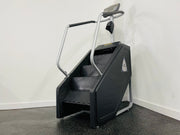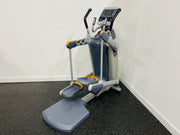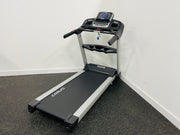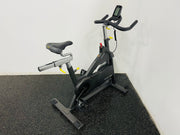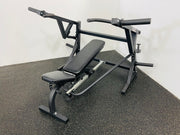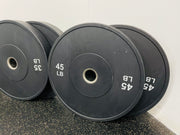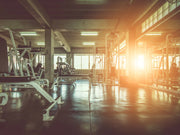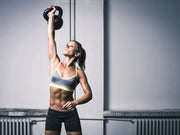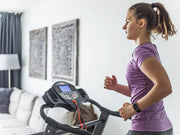Setting up a gym—whether it's in your garage or a whole commercial space—requires more than just weights and machines. One of the most overlooked but essential decisions is floor protection. The right flooring does more than prevent damage; it absorbs shock, adds traction, reduces noise, and creates a safe and stable environment for every workout.
But not all floors are created equal. What works well in a home setup may not be suitable for the demands of a commercial gym. If you're building or upgrading your space, understanding the differences helps you choose materials that last and perform optimally.
Why Floor Protection Matters
Between dropped dumbbells, heavy cardio machines, and repetitive impact from training, unprotected floors wear down fast. Cracks, dents, noise, and even minor shifting under equipment can all result from failing to install proper flooring. Furthermore, poor grip or uneven surfaces can lead to injury. Whether you're deadlifting or doing high-intensity intervals, you want a surface that supports—not fights—your training.
Best Options for Home Gym Flooring
In a home gym, you're likely working with a concrete basement, garage, or spare room. The equipment may include a squat rack, treadmill, or set of dumbbells—but the overall volume is lighter than in a commercial space.
Here are flooring materials that work well for home gyms:
-
Rubber Tiles (Interlocking): These are one of the most popular choices for home use. They're easy to install, provide excellent shock absorption, and can be removed or expanded without much hassle. It is ideal for bodyweight training, free weights, or even cardio machines like rowers or bikes.
-
Rubber Mats (Heavy-Duty Rolls): If you're placing equipment like a power rack or treadmill, thick rubber mats help distribute weight and reduce vibration. They stay flat, don't slide, and last longer than foam alternatives.
-
Foam Tiles: Best for light training or stretching areas. They're comfortable and affordable but not suitable for heavy weights or machines. Over time, foam compresses and loses support.
-
Horse Stall Mats: These are a budget-friendly, ultra-durable option often used in garage gyms and other areas where durability is essential. While heavy and not always easy to cut, they offer solid protection for lifting platforms and high-impact areas.
When considering in-home gyms, you also need to consider moisture—especially in garages or basements. Rubber is naturally resistant to water, making it a safer and cleaner option in humid or unpredictable environments.
Flooring for Commercial Gyms
A commercial gym presents different challenges, including higher traffic, heavier equipment, and more intense wear and tear. The flooring needs to withstand hundreds of workouts a week without shifting, warping, or deteriorating.
Recommended materials include:
-
Rubber Rolls (Commercial Grade): These are thick, seamless rolls of rubber flooring that cover large spaces. They're ideal for barbell training zones, strength equipment areas, and open functional fitness spaces. They're glued down or laid tight for maximum stability.
-
Turf Flooring: For sled work, agility drills, and performance zones, synthetic turf provides traction and impact support. It's not designed for heavy lifting, but it adds value to a mixed-training environment.
-
Platform Inserts and Lifting Zones: In commercial gyms, certain areas are specifically designed for Olympic lifting. These spaces use reinforced rubber or wood insets to handle barbell drops without damaging the foundation below.
-
Vinyl or PVC Flooring: In areas such as stretching zones, locker rooms, or office-adjacent training rooms, these surfaces are easier to clean and maintain—although not suitable for heavy equipment.
Commercial gyms also need to think about acoustic insulation. Dropped weights and running treadmills create noise that carries. High-density rubber or shock-absorbent subfloor layers help minimize disruption, especially in buildings with neighbors or multiple levels.
Choosing Based on Your Equipment
The flooring should match your training style. If you're only using resistance bands and yoga mats, thick foam or budget rubber might be enough. But if you're installing a Smith machine or placing multiple cardio stations, a more substantial base is essential. Even a single rowing machine or elliptical can leave marks over time if the floor underneath isn't protected.
Pay attention to floor thickness as well. For light training, 1/4" rubber tiles are enough. For weightlifting or commercial setups, 3/8" to 3/4" thickness is standard. If you're unsure, go thicker—it's rarely overkill.
Build the Right Foundation—Then Equip It Right
The right flooring sets the tone for every workout—but it's only part of the picture. Once your space is protected, the real impact comes from the equipment you choose to train with every day.
Uplift Equipment specializes in high-quality new and pre-owned fitness equipment that fits perfectly in both home gyms and commercial setups. Whether you're looking to upgrade your cardio zone or bring in strength machines built to last, we help you outfit your gym with the right tools to match your goals.

